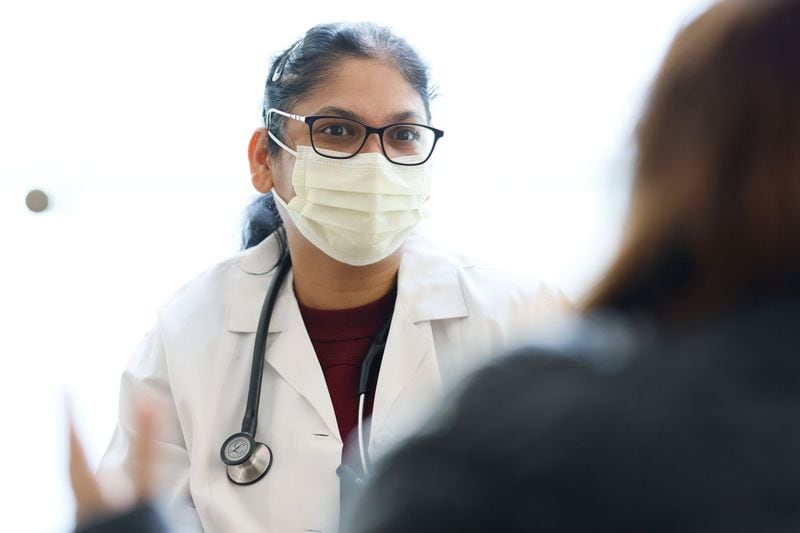The numbers at the Northeast Georgia Health System don’t lie. The COVID-19 summer surge is here.
“COVID has become part of our lives, but we never took our eyes off it,” said infectious disease doctor Supriya Mannepalli.
Since the outbreak of the pandemic in 2020, the Northeast Georgia Health System has administered COVID-19 tests to patients across all settings, including outpatient and long-term care facilities, to monitor transmission rates. As recently as April, roughly 2% of the tests came back positive.
“Now, we’re at 22% positivity, and this trend is going up,” Mannepalli said. “There is definitely a surge going on.”
The Centers for Disease Control and Prevention no longer tracks COVID-19 case numbers but estimates the trend of the virus spread based on emergency room visits. According to the CDC, in the week that ended July 13, Georgia reported 1.1% of emergency room visits were diagnosed as COVID-19, a 40% increase from the previous week — a high percentage that reflects a rise in the small number of emergency department cases. Nationally, 1.6% of all emergency visits were due to COVID-19, up 16% from the previous week.
The virus seems to be causing fewer emergency visits this summer than last year. During last summer’s peak, 2.5% of emergency department patients were diagnosed with COVID-19. It accounted for 3.5% of emergency patients in 2022, and 7% during summer 2021.
The CDC reports as of July 16 infections are growing or likely growing in 42 states and territories, including Georgia.
A summertime COVID-19 outbreak has become the norm since the pandemic, tied to people enjoying holiday travel and gathering indoors where it’s cooler. The virus has shown a seasonal surge twice each year, spiking in July and August, and again in December and January.
The CDC tracks a sample of over 300 hospitals in 13 states to estimate COVID-19 activity. For the week ended July 13, the agency reports a rate of 2 hospitalizations per 100,000 people. The highest rate of hospitalizations this year was reported for the week ended Jan. 6, when 7.6 hospitalizations per 100,000 people was reported.
Health experts and doctors have said they expect this summer’s COVID-19 illnesses to be milder than some past versions, but the latest iterations of the ever-evolving coronavirus seem to be more contagious.
At the Northeast Georgia Health System, Mannepalli said milder infections are the norm, with people presenting flu-like symptoms including coughing, runny nose, muscle aches, fever and sometimes sore throat. In more severe cases, shortness of breath can also be an issue.
COVID-19’s greater transmissibility is a product of the new, more contagious strains of the virus.
“There are new variants that keep evolving every few months. And as the new variants evolve, they (become) easily transmissible. That’s the way the virus tries to survive,” Mannepalli said.
The FDA has announced a new COVID-19 booster shot is expected to arrive in August or September and will better target the more recent variants.
Credit: Miguel Martinez
Credit: Miguel Martinez
For many people who have already had COVID-19, a reinfection is often milder. But those who are 65 and older, pregnant or immunocompromised remain at higher risk of serious complications from COVID-19.
Protocols for whether to isolate and wear a mask changed in March, when the CDC released new guidelines for people with COVID-19. They now recommend those with the infection treat it the same as the flu and RSV — staying home while they have symptoms and fever. The agency’s latest recommendation is that people can return to normal activities 24 hours after their fever has resolved and symptoms have improved.
The CDC encourages people recovering from COVID-19 or any other respiratory illness to wear a mask as part of an overall strategy to reduce transmission, but masks are not mandated. The CDC said the new guidelines are intended to make it easier for people to know how to protect others and take into account that other people might not know which virus they have.
Mannepalli said vaccination remains the number one precaution people can take, even as she allows that “everyone gets confused whenever they hear about a new vaccine for COVID.”
While newer vaccines might be more effective at blocking the variants now in circulation, Mannepalli recommends staying up to date with currently available vaccines rather than waiting for new boosters.
“Especially if somebody’s high risk of getting severe COVID or having complications from COVID, it’s so important that they stay up to date with the vaccination instead of delaying it,” she said.
For those seeking to minimize their exposure to COVID-19, Mannepalli says masks are advisable, especially in crowded indoor settings with poor ventilation. And if somebody has symptoms, they should source a test, so they can take steps to avoid passing the virus onto others if a COVID-19 infection is confirmed.
“I think the most important thing if somebody tests positive for COVID is to reach out to their primary care physician and talk to them,” she said, “so they can evaluate and see if they need to be started on antiviral medication.”
About the Author







